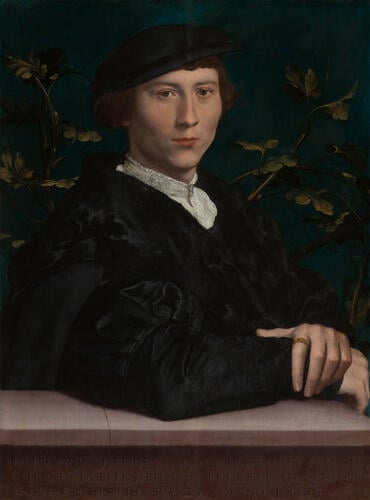-
1 of 253523 objects
Derich Born (1509/10 - after 1549) Signed and dated 1533
Oil on panel | 60.3 x 44.9 cm (support, canvas/panel/stretcher external) | RCIN 405681
-
Hans Holbein the Younger was born in Augsburg where he was trained by his father, Hans Holbein the Elder. He became a member of the painter's guild at Basel in 1519. He visited France in 1524 and first visited London in 1526-8. He returned to England in 1532 and shortly afterwards was employed by Henry VIII for whom he painted numerous portraits of the King, the Royal Family and members of the court. Holbein remained in royal service until his death (probably caused by plague) in 1543.
Derich Born (1509/10-after 1549) was a merchant from Cologne. In 1536 he supplied Henry VIII’s armourer, Erasmus Kyrkener, with military equipment for the suppression of the Northern Rebellion. However, in 1541 he and his elder brother were expelled from the London Steelyard (the walled area where the Hanseatic merchants resided and did business) after a dispute with the Duke of Suffolk concerning payment for a consignment of lead. Born is documented in Antwerp in 1542 and 1543, and last recorded in 1549, when he submitted a formal complaint about his expulsion while in Cologne.
This is one of a group of seven surviving portraits of German merchants by Holbein all painted c.1532-3 and perhaps intended to be sent home to the sitters’ families. It has been suggested that the pose in Barthel Bruyn’s portrait of a member of the Born family (previously James A. Stillmann, New York) may have been copied from Holbein’s painting and that therefore either Born’s portrait, a copy of it or the preparatory drawing was originally sent back to Germany. The relationship is not that close and it is more likely that Holbein’s portrait remained behind when Born left, since the portrait was in Charles I’s collection in the seventeenth century. No preparatory drawings survive for the Steelyard group. These might have been sent back to the merchant’s home for their families or it may be that Holbein did not use preparatory drawings for these portraits.
Derich’s wealth is subtly displayed in the very expensive satin doublet and black fur-lined gown. This restrained elegance was the fashion in Cologne. His face is centrally placed and confronts the viewer; his elbow is precisely centrally below his face and his body is turned at a perfect angle. Infrared reflectography reveals slight but careful adjustments to the outlines of his shoulders, head and cap with freehand lines. The right-hand contour of the face was redrawn three times.
The inscription on the stone ledge at the lower edge suggests that the portrait appears to be so lifelike that you would doubt whether it is painted (by the artist) or is in fact the real living person (the child created by the father):
DERICHVS SI VOCEM ADDAS IPSISSIMVS HIC SIT / HVNC DVBITES PICTOR FECERIT AN GENITOR / DER BORN ETATIS SV AE 23. ANNO 1533 . [If you added a voice, this would be Derich his very self. You would be in doubt whether the painter or his father made him. Der Born aged 23, the year 1533].
Catalogue entry adapted from The Northern Renaissance. Dürer to Holbein, London 2011Provenance
Acquired by Charles I; possibly given by him to the Earl of Arundel; Arundel inventory Amsterdam 1655; acquired by Charles II and recorded in the King's Closet at Whitehall in 1666 (no 321)
-
Creator(s)
(nationality) -
Medium and techniques
Oil on panel
Measurements
60.3 x 44.9 cm (support, canvas/panel/stretcher external)
75.9 x 61.0 x 6.0 cm (frame, external)
